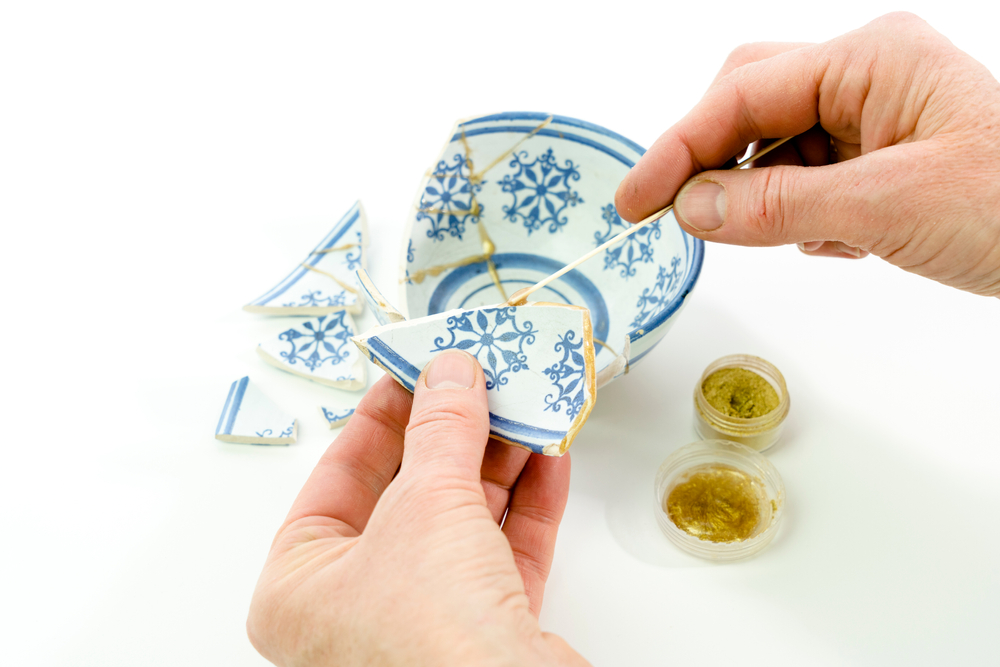In an earlier post, we spoke of how Kintsugi, a Japanese technique of joining broken pieces of pottery and celebrating the new whole it creates, along with its cracks and imperfections, can hold powerful lessons for the workplace. Here, let us explore what those lessons are and how they can impact both individuals as well as the organization.
- Keep calm when things break down
Our constant striving for perfection in the past 25 years has led to a generation of Millennials controlled and inhibited by their perfectionism, a study reveals. Worse still, the research indicated that these perfectionists tend to unravel as they grow older, leading to more neurotic behavior coupled with reduced conscientiousness. The result is, all too often, burnout.
Educator Aidan Harvey-Craig recommends turning to Kintsugi to help those who feel controlled by perfectionism or shame because of their brokenness.
To begin with, he suggests helping those who feel broken due to an instance of failure, say losing a project due to some performance issues, by cushioning the impact and softening the sharp edges created by the incident. Next, help to repair the damage incurred to the person – you could perhaps, help them do a root cause analysis and then tackle the issue, which might have been a poor communication style. Doing this requires patience; a shoddy repair job is the antithesis of Kintsugi and does not help an individual heal, correct the faulty behavior or build back confidence.
At a personal level, Kintsugi is also a harbinger of an optimistic spirit, as it reminds you to stay positive when things fall apart, as there is nothing that falls apart that cannot be fixed.
- Look for opportunities in every breakage
Aidan Harvey-Craig also points out that Kintsugi allows the cracks and the mending to be seen and in fact, even highlighted. The opportunity in the mending is what many disruptive models are made of.
For instance, the pandemic stalled the day-to-day operations of most businesses. But the fix, working from home, not just patched up the immediate problem but evolved to address some long-standing issues around bringing talented individuals back to the workforce through hybrid and remote working.
Another example was revealed by email resource website RGE’s co-founder Mike Nelson, who found out that the apology email he would send following an email blast that had a mistake would always perform well. Upon noticing this, the marketing team decided to include mistakes into their marketing emails once in a while, and follow it up with an apology email that would lead to greater engagement and orders. The lesson was that to err is human and giving customers the chance to forgive a breakage and appreciate the fix, was truly divine.
- Appreciate the sustainability of Kintsugi
Before consumerism made use-and-throw practices commonplace, repairing and reusing items was the done thing. Today, when conversations around talent and culture focus on the time and cost involved in hiring and training new recruits and the rising cost of attrition, the value of retaining employees rises multifold. And part of the retention process is being able to identify breaks in the employee’s journey, and in their relationships with others in the company, and finding ways to repair them beautifully.
For instance, as a manager or an HR partner, you can develop retraining programs for employees who are on the verge of becoming redundant, identify and create relocation or remote working opportunities for those who cannot come to the office, offer training, mentoring and new projects for those looking for promotions, and develop new roles or lateral hiring opportunities for those who need a different direction. In the long run, the accumulated knowledge and skills of these employees will reside within the company itself, while the challenges they faced during their employment history will be teachable moments within the organization.
And finally, lean in to the resilience your Kintsugi practice builds within you
Accepting and working with your breakages implies a capability for resilience that will win you respect from others. For instance, a team that has made mistakes and is willing to admit them, make amends, and learn from them is seen as tenacious. Others might also appreciate their creative and resourceful solutions to repair breakages and see them as valuable problem-solvers. They may even be seen as first movers who have already made the mistakes the rest of us are bound to make and therefore, are in the right position to advise us. Either way, the resilience of a Kintsugi practitioner is a valuable business advantage. And in this case, practice may not make it perfect, but it does make it better.








